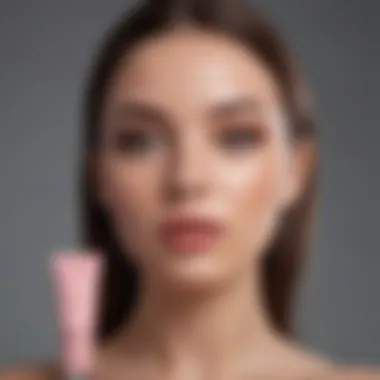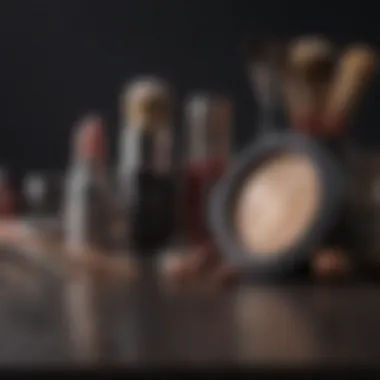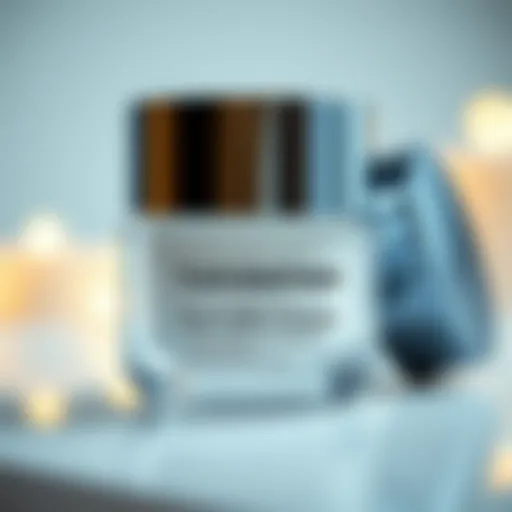Mastering Makeup: Concealing Pimples Effectively


Intro
Navigating the world of makeup, especially when dealing with pimples, can be a challenging experience. For many women, the desire to enhance beauty often collides with the reality of acne-prone skin. The focus of this article is to explore effective makeup solutions tailored specifically for concealing pimples. By understanding suitable products and application methods, women can not only achieve a polished look but also ensure their skin remains healthy.
The importance of proper skincare cannot be overlooked. It serves as the foundation for successful makeup application. After all, how makeup settles on the skin greatly relies on the condition of that skin. Therefore, integrating skincare strategies with makeup is essential.
Additionally, we will discuss the significance of choosing the right products, tools, and techniques. Rather than masking imperfections, the ultimate goal is to create a seamless appearance while being cautious not to aggravate existing skin issues. Throughout this guide, we aim to provide a comprehensive, practical, and insightful resource for women of all ages, empowering them to embrace beauty without sacrificing skin health.
Prologue to Makeup and Pimples
Makeup serves as a powerful tool for enhancing beauty, but it also puts focus on specific challenges like pimples and acne. This article aims to explore the profound connection between makeup and skin imperfections, particularly pimples. Understanding the effective strategies to conceal these often-unwanted marks not only boosts confidence but also helps individuals express their unique beauty.
From women of various age groups to those navigating through persistent skin problems, the overarching importance lies in the ability to address imperfections without compromising skin health. Using makeup effectively can be a double-edged sword. On one hand, it can provide coverage and improve appearance, but on the other hand, poor choices can lead to aggravated skin conditions. Thus, being aware of which products to use and how to apply them is critical.
Consider the types of formulations available in the market today. Many are specifically designed for acne-prone skin, aiming to cover imperfections adeptly while remaining gentle on the skin. This article digs into various product types, including foundations, concealers, and setting powders, which play a significant role in achieving that smooth and flawless finish.
Moreover, the context of using makeup is not just about aesthetic appeal, it also involves a significant consideration of skin health. Selecting non-comedogenic products can help maintain skin integrity, resisting breakouts in the long run. By integrating proper skincare practices alongside effective makeup solutions, readers can transform their makeup routine into a holistic experience that encourages beauty and skin vitality.
Overall, this exploration empowers readers with practical guidance that fosters confidence and enjoyment in their makeup application. The journey through the application techniques and essential tools will provide clarity and expertise, allowing for informed choices in makeup routines.
"Makeup is an art. But the canvas needs to be healthy for the art to exist beautifully."
As we proceed, understanding the makeup nuances surrounding pimples will help make informed decisions that elevate both appearance and skin condition.
Understanding the Nature of Pimples
Understanding the nature of pimples is essential for effective makeup application. This section provides insights into how different types of pimples can affect makeup choices and techniques. Recognizing these variations helps tailor concealing methods to individual skin needs. This understanding contributes to a more informed approach toward achieving desired aesthetics while managing skin health.
Types of Pimples
Different types of pimples present unique challenges for effective makeup solutions. Recognizing each type's characteristics allows for better preparation before applying makeup.
Whiteheads
Whiteheads are small, dome-shaped bumps that appear on the skin's surface. They are formed when hair follicles become clogged with oil and dead skin cells. The skin on whiteheads is typically smooth and is considered one of the mildest types of acne to treat with makeup. A key characteristic of whiteheads is that they are closed comedones, meaning they remain under the skin surface. This can make it easier to cover them with foundation and concealers. The advantage of using makeup on whiteheads is that a cream concealer can help create an even appearance without exacerbating the condition. However, it's crucial to apply products gently to avoid irritating the area further.
Blackheads
Blackheads are another common form of acne. They occur when a clogged pore opens to the skin's surface, allowing oxidation, which turns the clog black. Blackheads offer a unique parameter when using makeup, as they can sometimes be less visible under the right conditions. Their key feature is that, unlike other types, they can be treated easily with exfoliation. The advantage of covering blackheads with makeup is that they often blend well with skin tone when the right foundation or primer is used. However, heavy makeup can sometimes make them stand out more, so a light touch is advisable.
Cystic Acne
Cystic acne is the most severe and painful type of acne. It occurs when bacteria, oil, and dead skin cells build up deep within the skin. Unlike whiteheads and blackheads, cystic acne can be large and inflamed. Its key aspect is its tendency to be sensitive and tender, which poses a challenge for concealing it with makeup. The advantage of concealing cystic lesions lies in using a full-coverage foundation; however, specific techniques are essential to avoid worsening the condition. Understanding the sensitivity helps choose non-comedogenic products, which can minimize irritation while covering the blemish.
Papules and Pustules
Papules and pustules are both forms of inflammatory acne that can vary in size and appearance. Papules are small, red, and raised bumps, while pustules are similar but filled with pus. Both types can be quite noticeable. A key characteristic is their tendency to become inflamed, which makes best practices important during makeup application. The advantage of using concealers on papules and pustules is the possibility of covering redness while allowing for a smooth finish. However, it is crucial to avoid heavy layers to prevent the makeup from looking cakey or emphasizing the spot.
Determining Skin Sensitivity
Knowing your skin sensitivity is critical when selecting makeup products and techniques for concealing pimples. Each person has a unique response to ingredients and formulations. Those with sensitive skin may react adversely to typical formulations that work for others.
By understanding how your skin reacts to different products, you can avoid irritation and redness. Testing products on a small patch of skin before applying them more widely is a good practice. This approach can help prevent unexpected breakouts or allergies, which is especially important when dealing with acne conditions.
Makeup Formulations for Imperfection Coverage
Makeup formulations play a crucial role in effectively concealing imperfections such as pimples. The right products can not only mask blemishes but also prevent exacerbation of acne-prone skin. When selecting makeup, it is essential to understand how different formulations work, their impact on skin health, and their effectiveness in providing coverage without irritation. By choosing suitable products, individuals can enhance their beauty while maintaining skin health.


Foundations Suitable for Acne-Prone Skin
Foundations form the base of any makeup look. In the context of acne-prone skin, choosing the right foundation is vital.
Oil-free foundations
Oil-free foundations are specifically formulated to omit excess oils. They are beneficial for preventing clogged pores, which can lead to further breakouts. The key characteristic of oil-free foundations is their lightweight texture, which provides a natural finish. This makes them a popular choice for individuals with acne-prone skin.
One unique feature of oil-free formulations is the incorporation of matte-finish properties. These properties help in minimizing shine without appearing cakey. However, some may find that their coverage might not be as intense as creamier options.
Mineral-based options
Mineral-based foundations offer a different approach to coverage. These products are composed of natural minerals, which can be gentler on the skin. The key characteristic is that they usually do not contain additives or irritants found in traditional foundations. This is a beneficial choice for those who experience sensitivity.
A unique feature is the breathable formulation, which allows skin to stay healthy while providing decent coverage. However, some users might experience a powdery finish that may not work well for all skin types in every scenario.
Non-comedogenic products
Non-comedogenic foundations are designed specifically to avoid clogging pores. This characteristic is essential in any formulation for acne-prone skin. Non-comedogenic products are prevalent choices due to their skin-friendly nature. They often prioritize skin health alongside aesthetic appeal.
The uniqueness of these products lies in their formulation, which often includes ingredients that help in reducing inflammation. Nonetheless, individuals should still verify specific ingredients, as not all non-comedogenic foundations are impervious to irritation.
Concealers for Precision Coverage
Concealers provide targeted coverage essential for better results in covering pimples and blemishes. Each type of concealer offers unique features suited for different needs.
Liquid vs. cream concealers
Liquid concealers are water-based and offer a blendable texture. This characteristic contributes to their ability to cover slightly larger areas or more surface skin. They are often favored for their versatility and light finish, making them suitable for everyday wear.
In contrast, cream concealers tend to offer thicker coverage. The unique feature allows for better precision, especially on individual pimples. However, cream formulas can sometimes appear heavy, so caution is required to avoid a cakey look.
Color-correcting concealers
Color-correcting concealers are designed to target specific discolorations. Each color serves a different purpose, such as green for redness caused by acne. The primary characteristic of these concealers is their ability to neutralize colors that otherwise disrupt an even skin tone.
They are popular for their effective results but can sometimes require additional blending, which may take more time during application.
Stick concealers
Stick concealers are advantageous for their ease of application. They are portable, making them a favorite among busy individuals. The key characteristic is their solid form, which provides more concentrated coverage exactly where needed.
However, the thickness of these concealers can lead to a potential for clogging pores, so they should be chosen carefully based on individual skin types.
Setting Powders to Lock in Coverage
Setting powders play an essential role in maintaining the integrity of applied makeup. They ensure that foundations and concealers last longer while providing a polished look.
Translucent powders
Translucent powders are often favored for their ability to control shine. The primary characteristic of these powders is their sheer formulation, which does not alter the shade of the makeup underneath. Their effectiveness makes them a top choice for those seeking a natural finish.
A unique advantage is their lightweight feel, which prevents heaviness on the skin. On the downside, improperly applied powders can lead to a dusty appearance.
Matte setting powders
Matte setting powders serve to absorb excess oil. Their key characteristic is the matte finish they provide, ideal for those who struggle with shine throughout the day. Their effectiveness in keeping the makeup in place without reflecting light makes them a solid choice.
One unique feature is their ability to help ergonomically balance skin type needs. However, some may find that frequent touch-ups may be required, especially in hot weather.


Mineral powders
Mineral powders often combine benefits of both lightweight formulas and natural ingredients. Their key characteristic is that they deliver a natural finish while offering additional coverage to uneven skin. This is particularly beneficial for those looking to maintain skin health.
Unique to mineral powders is their potential anti-inflammatory properties, which can soothe the skin in different scenarios. However, they may also settle into fine lines if over-applied.
In summary, selecting the right makeup formulations is crucial for effectively concealing pimples while managing skin health. Whether it's foundations, concealers, or setting powders, understanding the unique qualities of each product can lead to better choices and results.
Application Techniques for Maximum Impact
The Base Layer: Applying Foundation
Foundation serves as the essential base for any makeup look. It creates an even canvas and hides redness or discoloration associated with pimples. When selecting a foundation for acne-prone skin, it is imperative to opt for formulations that are both oil-free and non-comedogenic. This reduces the likelihood of breakouts.
Begin by preparing the skin with a gentle moisturizer, allowing it to absorb fully. Use a foundation brush or a damp sponge for application. Starting from the center of the face, blend outward in smooth strokes. Concentrate on areas needing more coverage but avoid over-applying. Too much foundation can cake up and highlight imperfections instead of hiding them.
Targeted Concealing Techniques
Once the foundation is in place, it's time to address specific pimples. A precise concealer can make a significant difference in coverage. For this step, choosing the right concealer is crucial. Look for products with a thicker consistency which provides better coverage and also include those that are designed for specific skin concerns, such as redness.
To apply, use a small brush or your fingertip for better control. Dab the concealer directly onto the pimple. Gently press and pat it into the foundation instead of rubbing, as this can disrupt the base layer. If needed, follow with a light layer for added coverage.
Applying Setting Powder Effectively
Setting powder helps to lock in the foundation and concealer, keeping everything in place throughout the day. It is especially beneficial for oily skin types. Applying the right setting powder can prevent shine and ensure longevity in makeup wear.
After concealing, use a fluffy brush to lightly dust translucent setting powder over the face. Focus on the areas where you applied concealer. Avoid heavily layering it on the skin to maintain a natural look. Instead, apply it lightly and build it up if necessary. This technique helps also in blurring slight imperfections and keeping makeup looking fresh.
"Less is more when it comes to makeup application. A light hand can help achieve a natural finish."
By implementing these application techniques, concealing pimples becomes a straightforward process that emphasizes beauty while caring for the skin. This structured approach ensures a smooth finish, reducing visibility and promoting confidence in one’s appearance.
Essential Tools for Application
In the quest for a flawless makeup application, having the right tools is essential. A well-chosen array of brushes, sponges, and fingers can enhance the effectiveness of makeup products, particularly when seeking to conceal pimples. The distinctions between tools can yield different finishes, thus impacting the overall look you achieve.
Makeup tools not only help in the precise application of products but also assist in blending and achieving a natural finish. Poorly applied makeup can exacerbate blemishes, emphasizing imperfections rather than concealing them. Therefore, understanding the benefits and uses of each tool is crucial for a successful makeup routine tailored for acne-prone skin.
Makeup Brushes and Their Uses
Makeup brushes serve a variety of purposes, each designed for specific tasks. Using the appropriate brush can make a significant difference in coverage and finish. Here are some key brushes relevant for coverage of pimples:
- Flat Foundation Brush: Ideal for applying liquid foundation evenly across the skin's surface. It provides a good initial layer while minimizing the disturbance of existing blemishes.
- Concealer Brush: This smaller, more precise brush is designed for targeted application, allowing you to apply concealer directly onto pimples without affecting surrounding areas.
- Fluffy Brush: Useful for setting powders, a fluffy brush helps to create a more diffused look. It ensures that products are applied gently and evenly, reducing the risk of accentuating pimples.
Investing in quality brushes can elevate your makeup game, as they not only lead to better application but also improve the longevity of the makeup. Additionally, regular cleaning of brushes is vital for maintaining skin health. Dirty brushes can harbor bacteria that may lead to breakouts.
Sponges vs. Fingers for Application
When it comes to makeup application, the choice between using sponges or fingers often raises a debate. Each method has merits that can influence your finish.
- Sponges: Beauty sponges, especially those like the Beauty Blender, are favored for their ability to provide a flawless, airbrushed look. They work well for both foundation and concealer. The damp sponge technique allows for a sheer application of product, which can be built up gradually without appearing cakey.
- Fingers: Applying makeup with fingers can be beneficial for blending products seamlessly into the skin. The warmth from your fingers can help products melt into the skin, although this may not provide as much precision as a sponge or brush.
Ultimately, the choice comes down to personal preference and the specific look you aim to achieve. Mixing both methods can lead to efficient results, utilizing the sponge for an even base and fingers for targeted areas.
"The right application tools can significantly enhance your ability to conceal imperfections while maintaining skin health."
Understanding how to leverage these essential tools is a step towards achieving a polished look that addresses the unique challenges of concealing pimples.
Common Mistakes to Avoid


Makeup can be a powerful tool for women managing acne-prone skin. However, it's essential to understand that mistakes can undermine efforts to achieve a flawless appearance. Recognizing these common errors ensures better results and enhances skin health. Avoiding these pitfalls can lead to a more radiant look and healthier skin.
Over-application of Products
One major mistake people make is the over-application of makeup products. This can lead to a heavy and cakey appearance, making pimples more noticeable instead of concealing them. Applying too much product often stems from the desire to cover imperfections completely. However, layering on foundation and concealer can exacerbate the appearance of bumps or redness.
Here are some points to consider when it comes to the application of makeup:
- Use a light hand: Start with a thin layer of foundation. Build coverage gradually as needed.
- Choose the right formulation: Opt for lightweight, non-comedogenic products. This ensures that skin can breathe while still achieving decent coverage.
- Blending is key: Focus on blending rather than adding more product. A well-blended makeup look minimizes texture and helps conceal flaws effectively.
The goal is not to hide pimples entirely but to create a more even skin tone without adding unnecessary bulk, which only highlights imperfections.
Neglecting Skincare Routine
Another significant error is neglecting skincare routines while relying solely on makeup. Healthy skin is the foundation of any good makeup application. Without a proper skincare regimen, you may find that even the best products cannot deliver a flawless finish.
Consider these aspects of skincare:
- Cleanse regularly: Keeping the skin clean reduces the chance of clogged pores, which can lead to more breakouts.
- Moisturize daily: Even oily or acne-prone skin requires hydration. A lightweight, oil-free moisturizer can help maintain balance without exacerbating acne.
- Use sunscreen: Protecting the skin from UV rays is crucial. Some foundations offer SPF protection, but it shouldn’t replace dedicated sun protection.
- Exfoliate appropriately: Regular exfoliation removes dead skin cells, preventing buildup that could clog pores while promoting a smoother makeup application.
By establishing a consistent skincare routine, one can create an ideal canvas for makeup, ensuring better adherence and ultimately, a more polished look.
In summary, avoiding the over-application of makeup products and committing to a diligent skincare regimen are essential strategies. These practices not only enhance makeup results but also support long-term skin health.
Maintaining Skin Health While Using Makeup
The relationship between makeup and skin health is complex yet crucial. This section underscores the significance of maintaining skin health while utilizing makeup to conceal imperfections like pimples. The dual approach of enhancing beauty while adhering to skin health standards is essential, particularly for those with acne-prone skin.
Using makeup can temporarily boost confidence and provide immediate visual benefits. However, neglecting skin health can lead to worsened skin conditions, making it vital to acknowledge the potential impact of cosmetic products on the skin. Proper practices allow for seamless blending of skincare and cosmetics, resulting in a harmonious appearance without triggering further skin problems.
Daily Skincare Practices
Healthy skin acts as a foundation for successful makeup application. Establishing a consistent and effective skincare routine can significantly determine how makeup sits on the skin. Daily practices include cleansing, exfoliating, moisturizing, and protecting the skin from sun damage.
- Cleansing: Begin with a gentle cleanser designed for acne-prone skin. This helps remove impurities and excess oil, which can otherwise contribute to breakouts.
- Exfoliation: Regular exfoliation helps shed dead skin cells and promotes new cell growth. However, choose a product that is mild to avoid irritation. Over-exfoliating can lead to sensitivity and exacerbate acne issues.
- Moisturizing: Even oily skin requires hydration. Opt for a lightweight, oil-free moisturizer. This maintains skin balance and supports a smooth makeup application.
- Sun Protection: Daily application of a broad-spectrum sunscreen is essential—especially for acne-prone skin, which can be more susceptible to hyperpigmentation due to sun exposure. Look for non-comedogenic formulas that do not clog pores.
Overall, these practices create a healthy base that enhances makeup longevity and effectiveness.
Choosing Non-Comedogenic Products
Selecting the right products is another pillar of maintaining skin health. Non-comedogenic formulas are specifically designed to minimize the risk of clogging pores, thus reducing the chances of breakout. This requires understanding product labels and being selective about ingredients.
- Foundations: Ensure your foundation is labeled as non-comedogenic. This prevents foundation from blocking the skin and causing additional pimples.
- Concealers: Similar to foundations, choose concealers that explicitly say they are non-comedogenic. They should provide coverage without leading to further skin issues.
- Skincare: Always look for non-comedogenic moisturizers and sunscreens. These allow your skin to breathe, which is essential for reducing pore blockages.
By prioritizing non-comedogenic products, individuals can better protect their skin health while still enjoying the advantages of makeup.
"Makeup can be a tool for enhancement, but without proper skin care, it can easily become a detriment to your skin’s health."
In summary, maintaining skin health while using makeup involves a combination of diligent skincare practices and careful selection of products. This alignment helps in achieving a flawless appearance without compromising on skin condition.
Culmination: Finding the Right Balance
In the pursuit of flawless skin, especially for those with acne-prone conditions, achieving the right balance between enhancing beauty and maintaining skin health is crucial. Makeup can serve as a powerful tool to boost confidence, yet it can also aggravate existing skin issues if not used wisely. Therefore, understanding the nuances of both makeup and skin care is vital.
Finding this balance involves selective product choices and application techniques tailored to one’s unique skin type. For instance, opting for non-comedogenic foundations can prevent pore blockages while providing coverage. Also, regular skin care routines should not take a backseat; cleansing and moisturizing pave the way for better makeup application.
Moreover, practice is essential. Learning how to appropriately layer products—foundation, concealer, and setting powder—ensures not only that skin looks its best but also that it remains healthy. Over-application or using the wrong products can lead to a cascade of complications, which is counterproductive to the desired outcome.
Benefits of Finding the Right Balance
- Enhanced Confidence: Well-applied makeup can mask imperfections, giving individuals the confidence to face their day.
- Skin Health Improvement: Appropriate choices in makeup and skincare prevent further skin issues while enhancing appearance.
- Sustainable Practices: A balanced approach helps develop a routine that is compatible with one’s lifestyle and skin condition.
"Makeup should enhance, not mask, our natural beauty. It is about understanding how best to blend beauty routines with skin health."
By fine-tuning makeup techniques and respecting skin health, women of all ages can navigate the complexities of acne with poise. Each step taken in this direction contributes to a better overall aesthetic and personal comfort while reinforcing the importance of skin care. This diligent approach enables women to utilize makeup as an ally rather than a hindrance, leading to a sense of empowerment.







